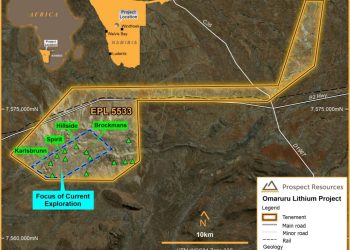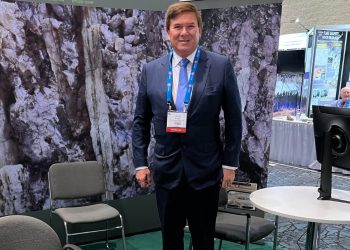
Andrada Mining has begun Stage 1 exploration at its Lithium Ridge project in Namibia, marking a key step in its strategy to diversify into battery minerals.
The exploration campaign follows the approval of a workplan and budget by the company’s Joint Development Committee with Chilean lithium producer SQM, and is being funded through a N$124 million (USD 7 million) facility.
Senior executives from both companies visited the site in May, underscoring their commitment to the project. Commercial discussions for the development of a lithium pilot plant are ongoing.
Alongside its lithium ambitions, Andrada is progressing with the construction of a new jig plant at its flagship Uis mine.
The front-end crushing circuit has been delivered to site, and fabrication of key components is underway.
Civil works for the plant have been completed, with initial production targeted for the second half of 2025.
Components for the pre-concentration circuit, including Metso crushers and ore sorters, have also arrived and are awaiting installation pending re-engineering of the existing systems.
“Construction of the new jig plant is advancing well,” said Andrada CEO Anthony Viljoen.
“As we look ahead, Andrada remains focused on operational excellence, disciplined capital deployment, and the strategic development of our diversified critical minerals portfolio.”
The company has also reported a solid operational performance for the first quarter ended 31 May 2025 (Q1 FY2026). Ore processed at Uis rose 7% year-on-year to 254,745 tonnes, supported by upgrades to the Dense Media Separation (DMS) circuit and the installation of new shaking tables under its Continuous Improvement 2 (CI2) programme.
“During the quarter, we were delighted to see solid performance improvements at our Uis operation supported by enhancements from our CI2 programme,” said Viljoen.
“These modifications drove an increase in processing rates and tin production, highlighting the growing efficiency and reliability of our operations.”
Tin concentrate output rose by 11% year-on-year to 405 tonnes, while contained tin production increased 2% to 238 tonnes. The plant utilisation rate improved to 93%, up from 90% the previous year, and processing rates climbed 6% to 142 tonnes per hour.
The average tin grade declined by 4% year-on-year to 0.136% due to the use of blended ore, though it improved slightly compared to the previous quarter. Higher throughput helped offset the lower grade.
Byproduct output also improved, with saleable tantalum concentrate production rising to 12.1 tonnes from 8.6 tonnes a year earlier. Around 10 tonnes were shipped to offtake partner Afrimet during the quarter.
Financially, Andrada benefited from stronger tin prices and lower operating costs. The average tin price rose by 7% year-on-year to N$585,695 (USD 32,993) per tonne. C1 costs fell by 11% quarter-on-quarter to N$335,485 (USD 18,901), while C2 costs declined 3% to N$428,464 (USD 24,139). The all-in sustaining cost (AISC) dropped 2% to N$514,723 (USD 28,999) per tonne.
“Operational cost performance improved overall, driven by ongoing proactive cost-reduction initiatives that are expected to enhance cash flows over the course of the year,” Viljoen said.
“This includes the completion of a group-wide corporate restructuring, which is expected to further rationalise the cost base and strengthen overall profitability.”







